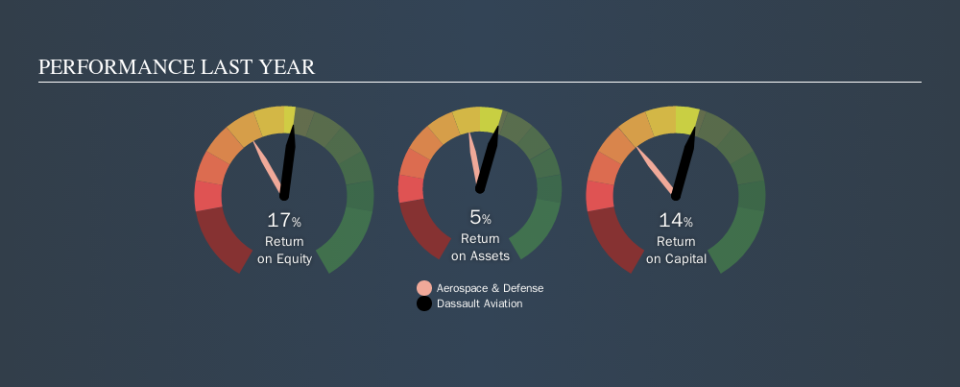Are Dassault Aviation SA’s (EPA:AM) High Returns Really That Great?

Today we'll look at Dassault Aviation SA (EPA:AM) and reflect on its potential as an investment. To be precise, we'll consider its Return On Capital Employed (ROCE), as that will inform our view of the quality of the business.
First up, we'll look at what ROCE is and how we calculate it. Then we'll compare its ROCE to similar companies. And finally, we'll look at how its current liabilities are impacting its ROCE.
Return On Capital Employed (ROCE): What is it?
ROCE measures the 'return' (pre-tax profit) a company generates from capital employed in its business. In general, businesses with a higher ROCE are usually better quality. In brief, it is a useful tool, but it is not without drawbacks. Author Edwin Whiting says to be careful when comparing the ROCE of different businesses, since 'No two businesses are exactly alike.
So, How Do We Calculate ROCE?
Analysts use this formula to calculate return on capital employed:
Return on Capital Employed = Earnings Before Interest and Tax (EBIT) ÷ (Total Assets - Current Liabilities)
Or for Dassault Aviation:
0.14 = €598m ÷ (€17b - €12b) (Based on the trailing twelve months to June 2019.)
So, Dassault Aviation has an ROCE of 14%.
Check out our latest analysis for Dassault Aviation
Does Dassault Aviation Have A Good ROCE?
ROCE is commonly used for comparing the performance of similar businesses. Using our data, we find that Dassault Aviation's ROCE is meaningfully better than the 9.3% average in the Aerospace & Defense industry. We would consider this a positive, as it suggests it is using capital more effectively than other similar companies. Independently of how Dassault Aviation compares to its industry, its ROCE in absolute terms appears decent, and the company may be worthy of closer investigation.
Our data shows that Dassault Aviation currently has an ROCE of 14%, compared to its ROCE of 7.4% 3 years ago. This makes us think the business might be improving. You can see in the image below how Dassault Aviation's ROCE compares to its industry. Click to see more on past growth.
When considering this metric, keep in mind that it is backwards looking, and not necessarily predictive. ROCE can be misleading for companies in cyclical industries, with returns looking impressive during the boom times, but very weak during the busts. ROCE is, after all, simply a snap shot of a single year. Since the future is so important for investors, you should check out our free report on analyst forecasts for Dassault Aviation.
Dassault Aviation's Current Liabilities And Their Impact On Its ROCE
Current liabilities include invoices, such as supplier payments, short-term debt, or a tax bill, that need to be paid within 12 months. Due to the way ROCE is calculated, a high level of current liabilities makes a company look as though it has less capital employed, and thus can (sometimes unfairly) boost the ROCE. To check the impact of this, we calculate if a company has high current liabilities relative to its total assets.
Dassault Aviation has total assets of €17b and current liabilities of €12b. As a result, its current liabilities are equal to approximately 74% of its total assets. This is admittedly a high level of current liabilities, improving ROCE substantially.
What We Can Learn From Dassault Aviation's ROCE
While its ROCE looks decent, it wouldn't look so good if it reduced current liabilities. Dassault Aviation looks strong on this analysis, but there are plenty of other companies that could be a good opportunity . Here is a free list of companies growing earnings rapidly.
I will like Dassault Aviation better if I see some big insider buys. While we wait, check out this free list of growing companies with considerable, recent, insider buying.
We aim to bring you long-term focused research analysis driven by fundamental data. Note that our analysis may not factor in the latest price-sensitive company announcements or qualitative material.
If you spot an error that warrants correction, please contact the editor at editorial-team@simplywallst.com. This article by Simply Wall St is general in nature. It does not constitute a recommendation to buy or sell any stock, and does not take account of your objectives, or your financial situation. Simply Wall St has no position in the stocks mentioned. Thank you for reading.

